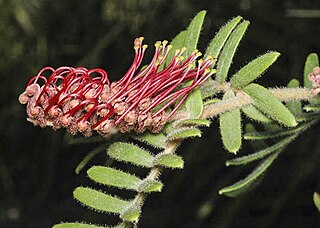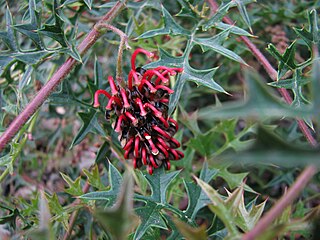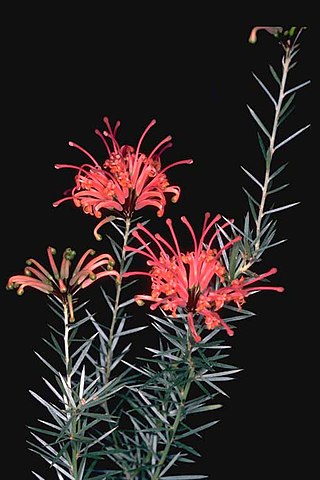
Grevillea humifusa, commonly known as spreading grevillea, is a species of flowering plant in the family Proteaceae and is endemic to a restricted area of the south-west of Western Australia. It is a prostrate shrub with long, trailing stems, divided lives with linear lobes and clusters of pink to pale red and cream-coloured flowers with a reddish, yellow-tipped style.

Grevillea preissii is a species of flowering plant in the family Proteaceae and is endemic to the southwest of Western Australia. It is a mounded to spreading or dense, erect shrub, the leaves divided with 5 to 7 linear to more or less cylindrical lobes, and groups of reddish flowers arranged along one side of the flowering rachis.

Grevillea excelsior, commonly known as flame grevillea or yellow flame grevillea, is a species of flowering plant in the family Proteaceae and is endemic to the south-west of Western Australia. It is an erect shrub or small tree with usually divided leaves with linear lobes, and clusters of orange flowers.

Grevillea caleyi, also known as Caley's grevillea, is a critically endangered species of flowering plant in the family Proteaceae and is endemic to a restricted area around the Terrey Hills and Belrose area in New South Wales. It is an open, spreading shrub, growing up to 4 m (13 ft) tall with deeply divided leaves with linear lobes, and fawn flowers with a maroon to red style.

Grevillea pimeleoides is a species of flowering plant in the family Proteaceae and is endemic to the south-west of Western Australia. It is an erect shrub with elliptic to egg-shaped leaves with the narrower end towards the base, and clusters of yellow or orange flowers.

Grevillea glossadenia is a species of flowering plant in the family Proteaceae and is endemic to Queensland, in northeastern Australia. It is an erect shrub with more or less elliptic leaves and deep yellow-orange to orange-red flowers.

Grevillea pinaster is a species of flowering plant in the family Proteaceae and is endemic to the south-west of Western Australia. It is an erect shrub with linear leaves and pinkish-red to red flowers, the style with a yellowish tip.

Grevillea infecunda, commonly known as Anglesea grevillea, is a species of flowering plant in the family Proteaceae and is endemic to a restricted area of southern Victoria in Australia. It is a low-lying to weakly erect shrub with divided leaves with three to sixteen lobes or teeth and greenish-yellow flowers with a dull pink style.

Grevillea celata, commonly known as Nowa Nowa grevillea or Colquhoun grevillea, is a species of flowering plant in the family Proteaceae and is endemic to a restricted part of Victoria in Australia. It is an erect and open to low, dense shrub with oblong, broadly elliptic or linear leaves, and red and yellow, or red, white and apricot-coloured, sometimes all yellow flowers.

Grevillea montis-cole, commonly known as Mount Cole grevillea, is a species of flowering plant in the family Proteaceae and is endemic to central-western Victoria, Australia. It is a shrub with divided leaves with 5 to 15 lobes, the end lobes more or less triangular to narrowly oblong and sharply-pointed, and clusters of greenish to fawn and dull purplish flowers.

Grevillea ilicifolia, commonly known as holly grevillea or holly bush, is a species of flowering plant in the family Proteaceae and is endemic to southern continental Australia. It is a spreading to prostrate shrub with holly-like leaves with sharply-pointed triangular to egg-shaped teeth or lobes, and clusters of green to cream-coloured and mauve flowers with a pink to red style.
Grevillea hockingsii is a species of flowering plant in the family Proteaceae and is endemic to south-eastern Queensland. It is an erect shrub with oblong to narrowly elliptic leaves and clusters of reddish-pink flowers.

Grevillea exposita is a species of flowering plant in the family Proteaceae and is endemic to the south-west of Western Australia. It is a dense, spreading shrub with mostly oblong to narrowly elliptic leaves and clusters of bright red and white flowers.

Grevillea kennedyana, also known as flame spider-flower, is a species of flowering plant in the family Proteaceae and is endemic to a restricted area of inland eastern Australia. It is an erect shrub with many branches, usually linear leaves and erect clusters of rich red flowers.

Grevillea brachystylis, also known as short-styled grevillea, is a species of flowering plant in the family Proteaceae and is endemic to the south-west of Western Australia. It is a low, spreading to erect shrub with linear to narrow egg-shaped leaves with the narrow end towards the base, and wheel-like clusters of hairy red flowers.

Grevillea decora is a species of flowering plant in the family Proteaceae and is endemic to Queensland. It is an erect shrub or small tree with a single main stem, oblong, oval or egg-shaped leaves, and groups of pinkish red or pink flowers.

Grevillea fistulosa, commonly known as Barrens grevillea or Mount Barren grevillea, is a species of flowering plant in the family Proteaceae and is endemic to the Fitzgerald River National Park in the south-west of Western Australia. It is an erect shrub with narrowly egg-shaped to broadly linear leaves and clusters of orange-red to scarlet flowers.

Grevillea gordoniana is a species of flowering plant in the family Proteaceae and is endemic to the west of Western Australia. It is an erect shrub or small tree with cylindrical leaves and yellow to orange flowers.

Grevillea hakeoides is a species of flowering plant in the family Proteaceae and is endemic to the south-west of Western Australia. It is a spreading shrub with flat, linear or more or less-cylindrical leaves and dome-shaped groups of flowers, the colour varying according to subspecies.

Grevillea zygoloba is a species of flowering plant in the family Proteaceae and is endemic to the south-west of Western Australia. It is an erect shrub with divided leaves, the lobes linear and more or less parallel, and clusters of creamy-white flowers.






















